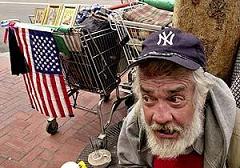More than 15 million Americans are unemployed, homelessness has increased by 50 percent in some cities, and 38 million people are receiving food stamps, more than at any time in the program’s almost 50-year history.
 Evidence of rising economic hardship is ample. There’s one commonly used standard for measuring it: the U.S. Census Bureau’s poverty rate. It guides much of federal and state spending aimed at helping those unable to make a decent living.
Evidence of rising economic hardship is ample. There’s one commonly used standard for measuring it: the U.S. Census Bureau’s poverty rate. It guides much of federal and state spending aimed at helping those unable to make a decent living.
But a number of states have become convinced that the federal figures actually understate poverty, and have begun using different criteria in operating state-based social programs. At the same time, conservative economists are warning that a change in the formula to a threshold that counts more people as poor could lead to an unacceptable increase in the cost of federal and state social service programs.
When Census publishes new numbers for 2009 in September, experts predict they’ll show a steep rise in the poverty rate. One independent researcher estimates the data will show the biggest year-to-year increase in recorded history.
According to Richard Bavier, a former analyst for the federal Office of Management and Budget, already available data about employment rates, wages, and food stamp enrollment suggest that an additional 5.7 million people were officially poor in 2009. That would bring the total number of people with incomes below the federal poverty threshold to more than 45 million. The poverty rate, Bavier expects, will hit 15 percent — up from 13.2 percent in 2008, when the Great Recession first started to take its toll.
Still, the U.S. Census Bureau’s new numbers will offer only a partial picture of how the nation’s sputtering economy is affecting the poorest Americans — a problem state officials and the Obama administration want to address.
Overestimating food costs
The current formula for setting the federal poverty line — unchanged since 1963 — takes the cost of food for an individual or family and multiplies the number by three, under the assumption that people spend one-third of their incomes putting meals on the table. While the formula may have been a good way to estimate a subsistence cost of living in the early 1960s, experts say food now represents only one-eighth of a typical household budget, with expenses such as housing and child care putting increasing pressure on struggling families.
In addition, the official measure fails to account for regional differences in the cost of housing, it doesn’t include medical expenses or transportation, and at $22,000 for a family of four, the poverty line is considered by many to be simply too low.
Equally worrisome for policy makers is the Census Bureau’s failure to consider in-kind federal and state aid in calculating income. The existing formula counts only pre-tax cash income, leaving out such benefits as food stamps, housing vouchers and child-care subsidies, as well as federal and state tax credits for the working poor.
As a result, the nation’s official poverty count is unaffected by the billions spent on safety-net programs. Yet it remains by far the most frequently used measurement of how well governments are taking care of their most vulnerable citizens.
Conservatives have consistently argued that if safety-net programs were taken into account, the poverty rate would be much lower. At the same time, advocates for the poor have argued that poverty counts would be much higher if the cost of housing, child care and other expenses were factored in.
Nearly two decades ago, Congress asked the National Academies of Science (NAS) to revisit the official poverty measure and come up with recommendations for a new measure that would satisfy critics on both ends of the spectrum.
This past March, the Obama administration said it would use the NAS 1995 guidelines to update the federal government’s poverty calculation and promised to unveil the first new “supplemental poverty measure” in September of 2011.
“The new supplemental poverty measure will provide an alternative lens to understand poverty and measure the effects of anti-poverty policies,” Under Secretary of Commerce Rebecca Blank said. “Moreover, it will be dynamic and will benefit from improvements over time based on new data and new methodologies.”
Under the NAS recommendations, Commerce Department expenditure data for food, clothing, shelter and other household expenses would be used to set a poverty threshold for a reference family of four — two adults and two children. Then a family or individual’s resources would be compared to that line by including income and in-kind benefits, with taxes and other non-discretionary expenses, such as medical expenses and child care, excluded.
Because many expect the new calculation will result in a higher poverty count, the March announcement met with fiery criticism from some conservatives who charged the federal government could ill afford to increase its safety-net spending.
State experiments
But state and local policy makers applauded the move because they said it would give them the tools they need to assess the effectiveness of anti-poverty programs.
In New York City, for example, where an NAS-type poverty measure was adopted three years ago, Mayor Michael Bloomberg said the new data would allow the city to pinpoint who needs assistance most and which of the city’s social services have been most effective at improving its residents’ standard of living.
Using an updated measurement, New York City found that children — the recipients of a broad range of social welfare programs — were less poor than originally thought, while elders, who were struggling with previously unaccounted for medical expenses, were poorer.
As states become increasingly challenged by shrinking revenues and rising numbers of people in need, more than a dozen have set up commissions to help low-income families and many have set poverty reduction goals.
Among them, Minnesota and Connecticut have used NAS-like formulas to assess the effectiveness of current and proposed anti-poverty measures.
With technical assistance from the public policy research group The Urban Institute, both states used the results to support aggressive anti-poverty campaigns. Minnesota has a Legislative Commission to End Poverty in Minnesota by 2020, and Connecticut created a Child Poverty and Prevention Council with the goal of cutting child poverty in half by 2014.
Connecticut found only a slight increase in the number of people living in poverty when using the updated calculation — 21,000 people in 2006, compared to 20,000 using the existing Census measure.
But it got very different results when determining which public assistance programs did the most to reduce poverty. Under previous assumptions, child care subsidies and adult education and job training were seen as the most highly effective at moving people out of poverty over time. But the new formula showed that increasing enrollment in programs such as food stamps, energy assistance and subsidized housing was a more effective way to reduce child poverty in the near term. As a result, the state redoubled its outreach efforts to sign up as many low-income families as possible for these federally-funded programs.
In Minnesota, where the results were similar, a bipartisan legislative committee recommended the state refine its definition of poverty, build public awareness, and carefully monitor the impact of all major legislation on existing anti-poverty programs.
Both states joined 12 others earlier this year in calling on the federal government to adopt an NAS-like formula that would “consider the increased financial burden of housing, child care, and health care on the modern American family while recognizing the benefit of critical work supports such as tax credits, food stamps, and other non-cash subsidies.”
The administration’s supplemental poverty measure remains controversial, and some leaders on both ends of the political spectrum are urging Congress and the administration not to adopt the new formula for purposes of allocating federal funding or determining individual eligibility anytime soon.
If used to parse federal grants among states, it could radically change the amount of money each state receives. It stands to reason, for example, that a family of four trying to make it on $22,000 would have an easier time in rural Alabama than they would in suburban Massachusetts. And should the new measure be used to set individual eligibility for safety net programs, some are fearful that current recipients would be disqualified if all of their federal and state benefits were counted.
For the Obama administration, the Census Bureau’s current measure is problematic because it will fail to show the benefits of at least $100 billion in 2009 stimulus money spent for low-income families. Even so, as those direct subsidies and other job-creating federal funds are phased out, advocates expect the poverty rate will shoot up again next year, when the data is in for 2010.
 Image via Wikipedia
Image via Wikipedia










